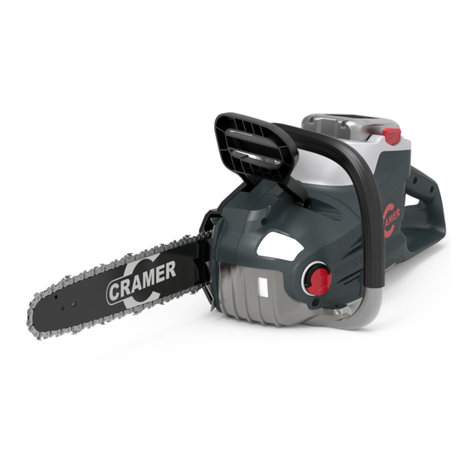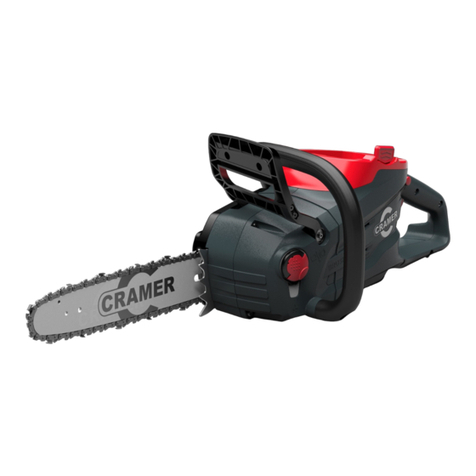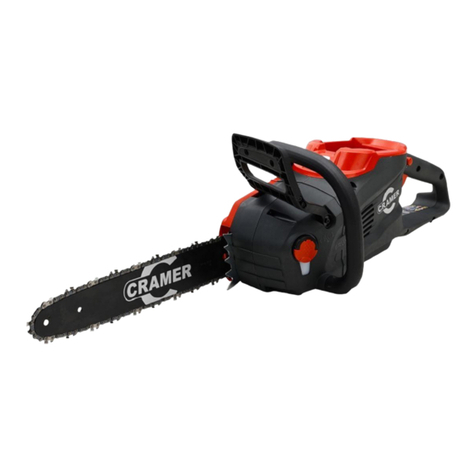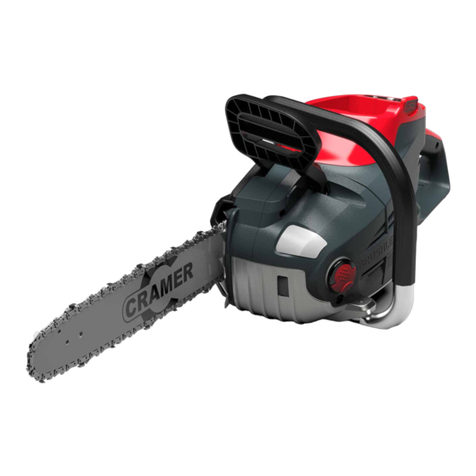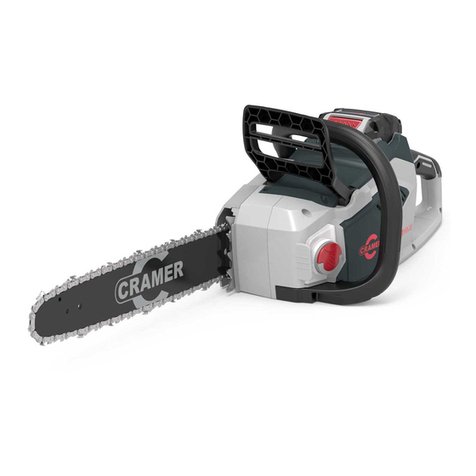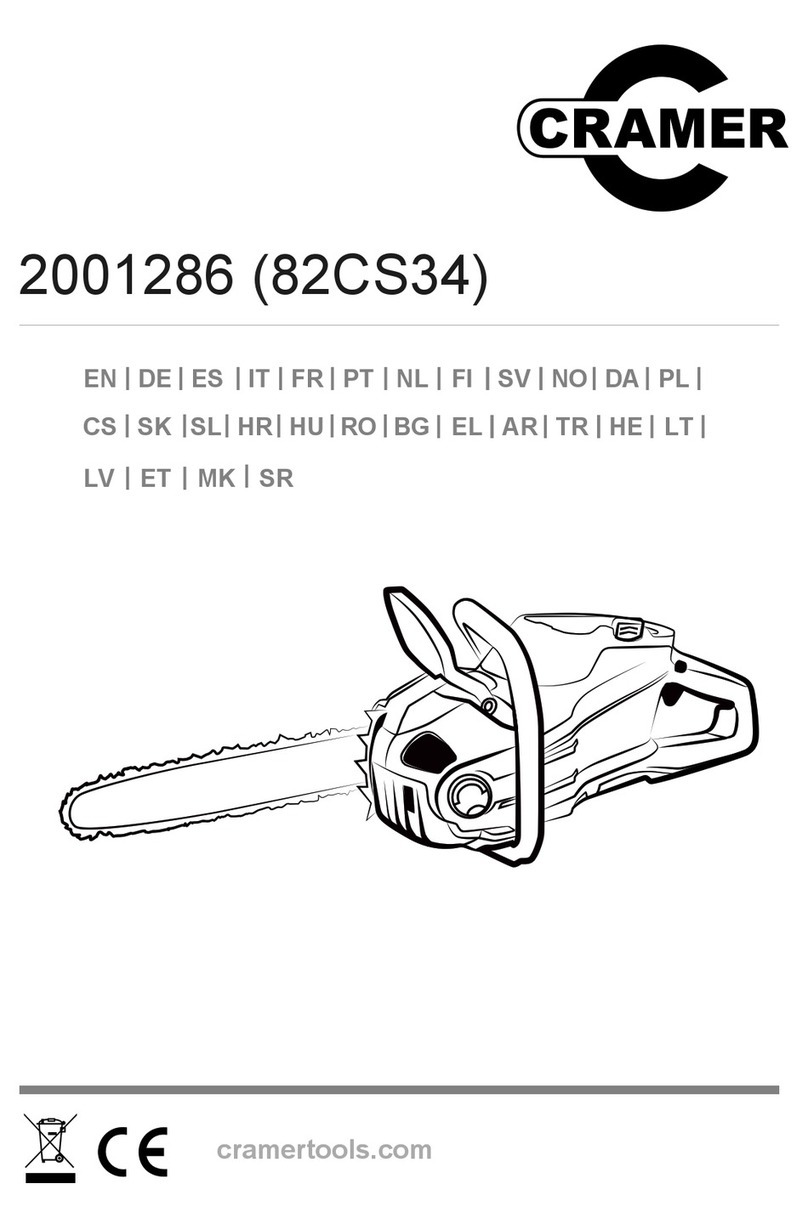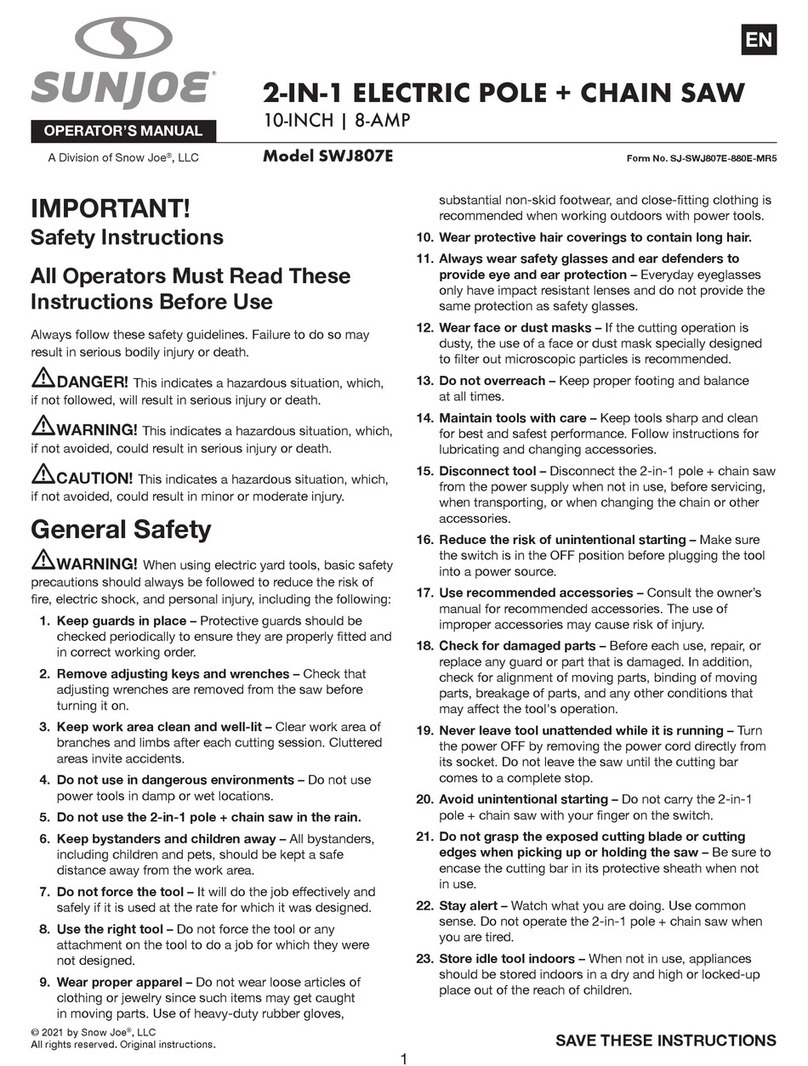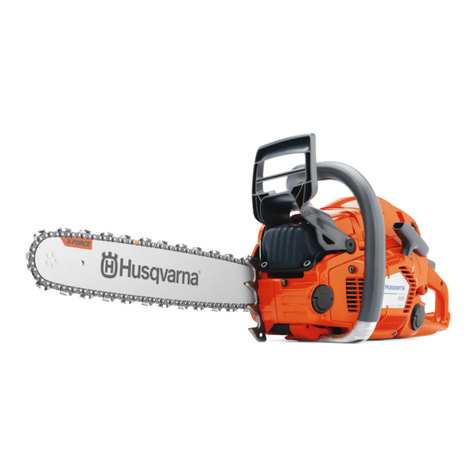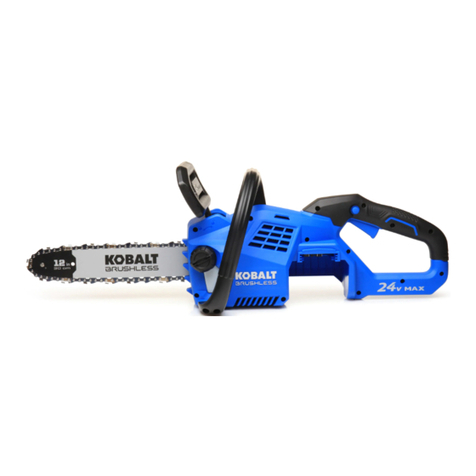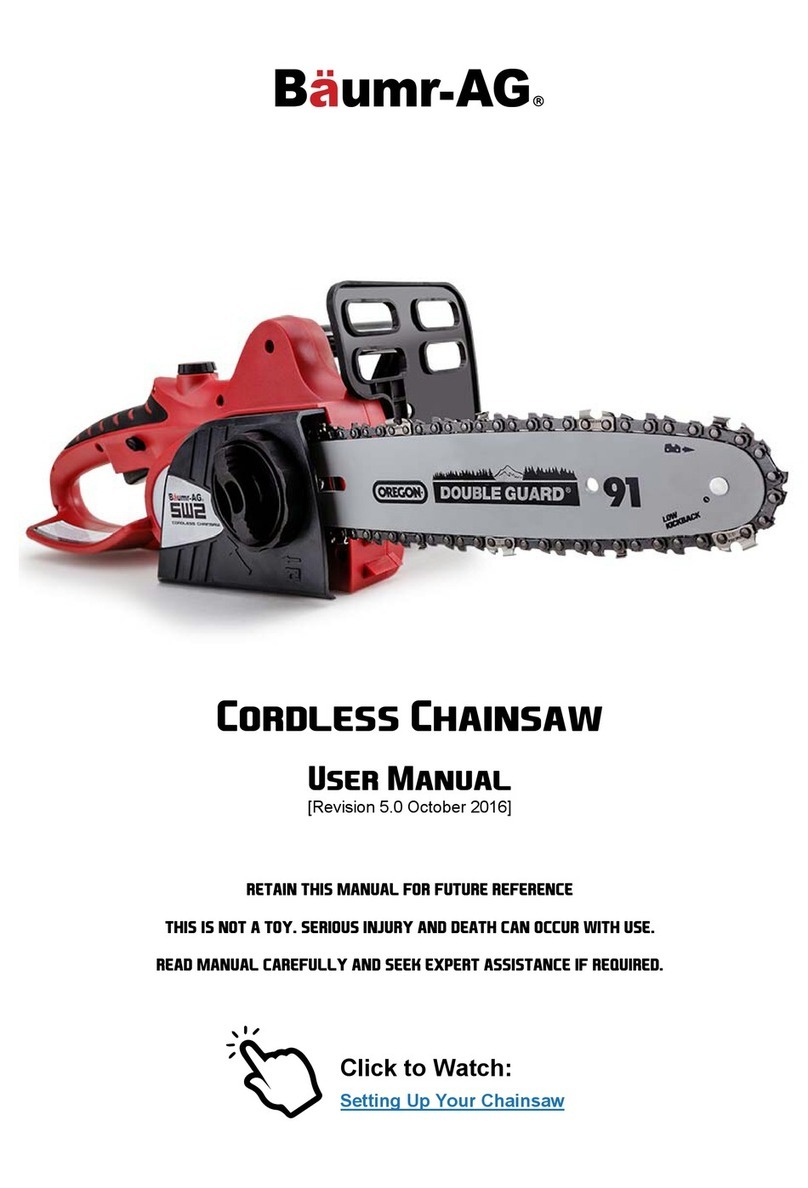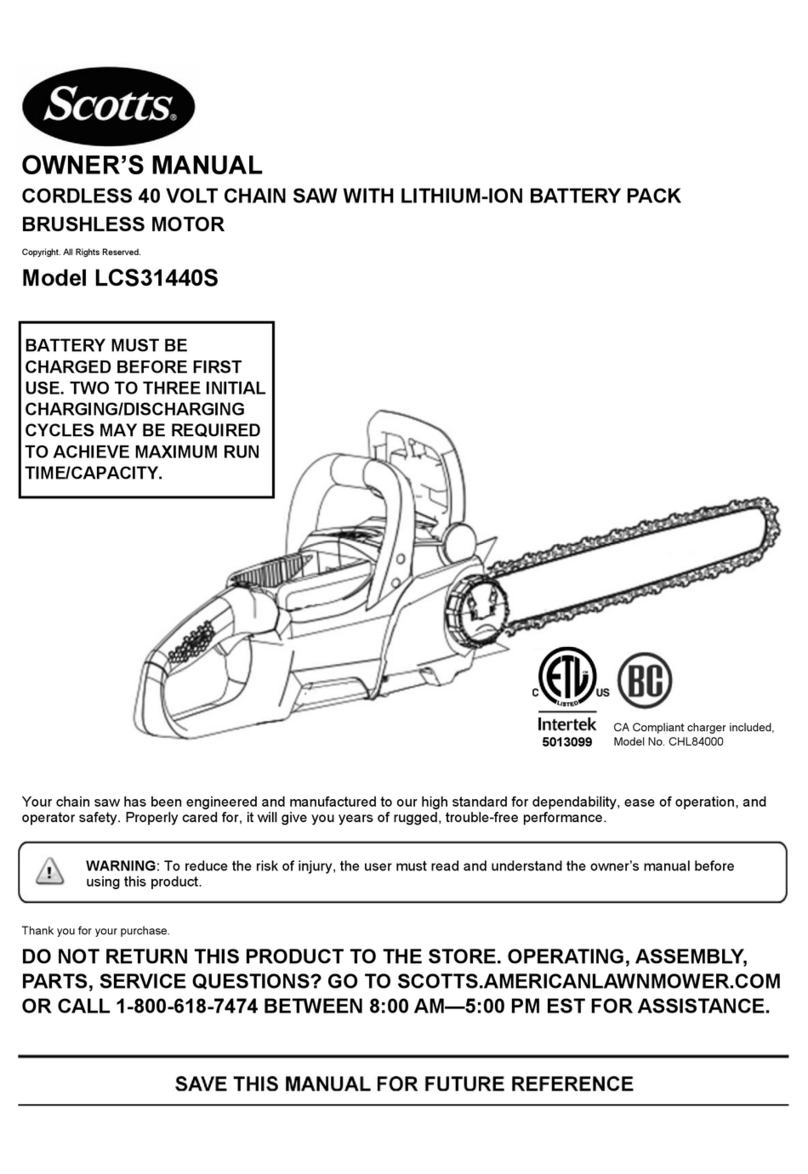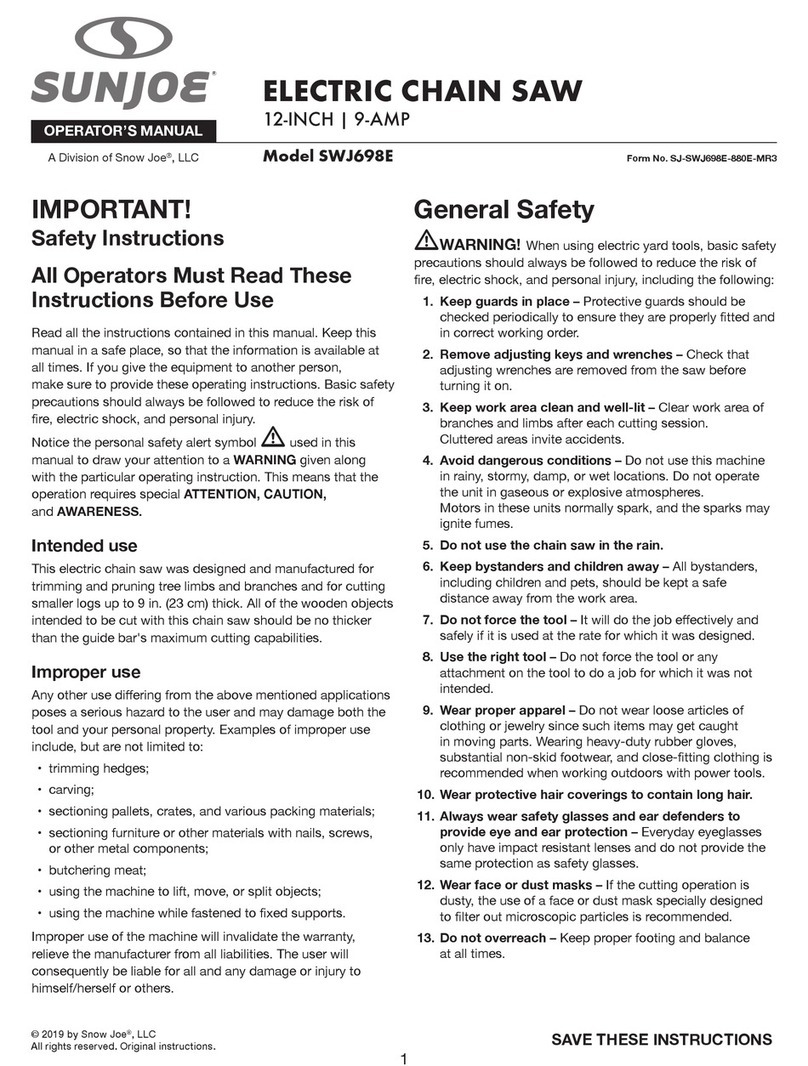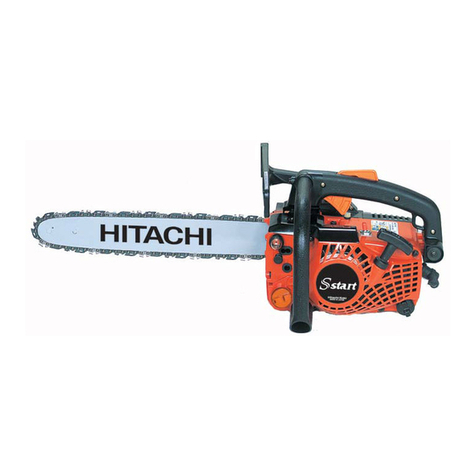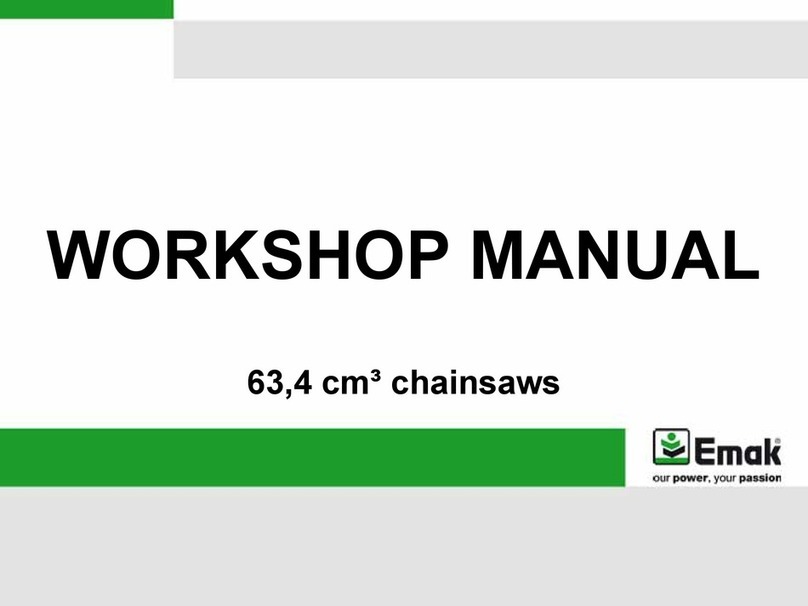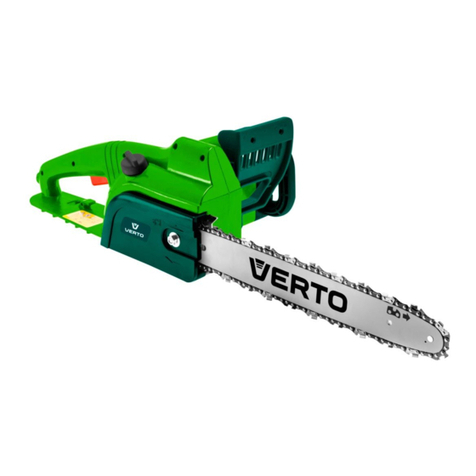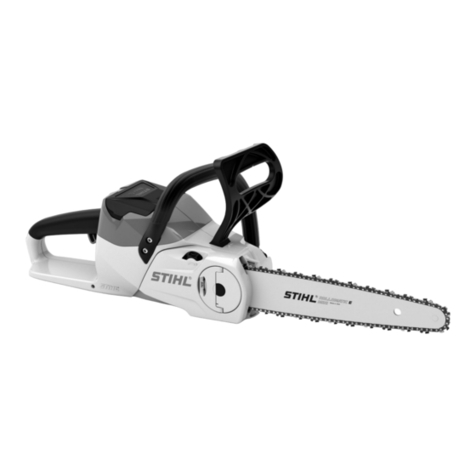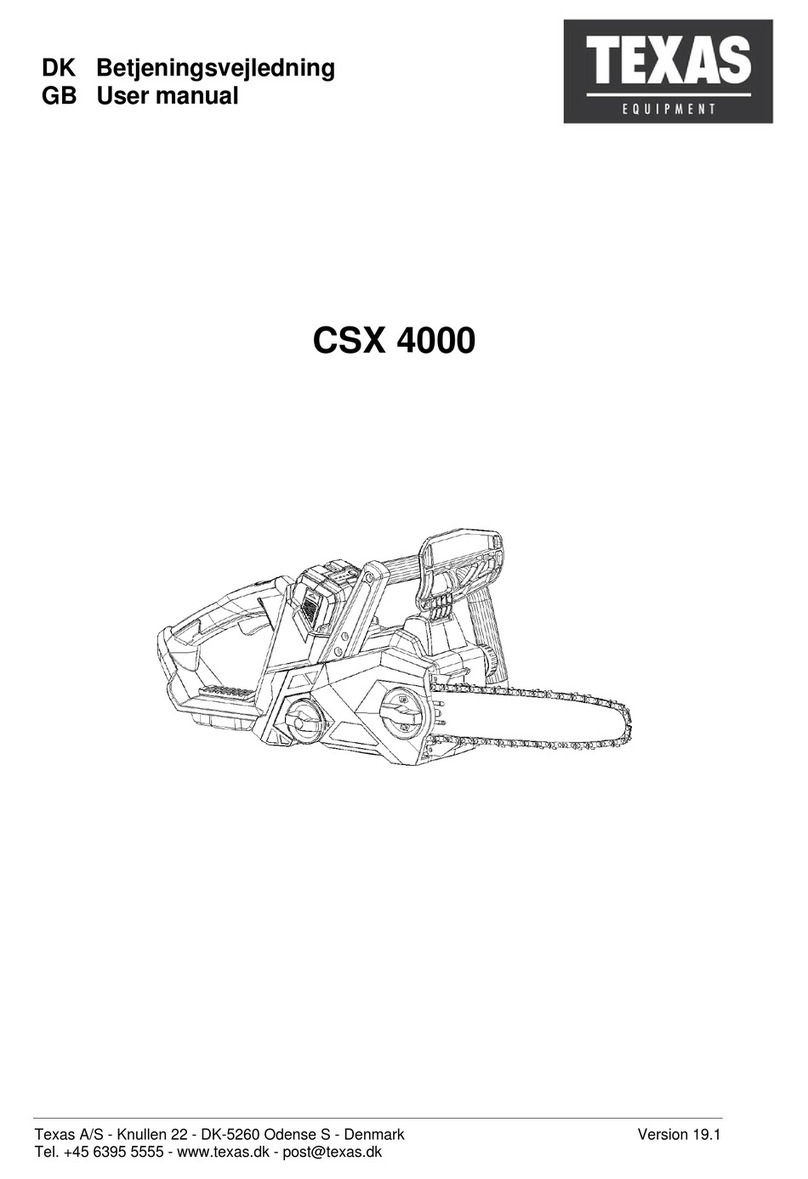Cramer 40CS12 User manual

cramer.eu
2000186/2000286(40CS12/40CS15)
EN | DE | ES | IT | FR | PT | NL | RU| FI | SV | NO| DA| PL | CS | SK | SL| HR|
EL | AR| TR | LT | LV | ET |

Fig. 1
Fig. 5
Fig. 11
Fig. 17 Fig. 18 Fig. 19 Fig. 20 Fig. 21 Fig. 22
Fig. 12 Fig. 13 Fig. 14 Fig. 15 Fig. 16
Fig. 6 Fig. 7 Fig. 8 Fig. 9 Fig. 10
Fig. 2 Fig. 3 Fig. 4.
20
33
32 34
36
35
36
37 35
38
39
23
24
25
26
27
28
29
25
24
50mm
21
22
50mm
30
31
40CS15 (2000286)
40CS12 (2000186)
14
5
7
6
9
2
3
8
10
11
12 15
13
14
18
11
19
17
18

2cramer.eu
EN Product Overview
Your machine has been engineered and manufactured to high standard for
dependability, ease of operation, and operator safety. When properly cared for, it
will give you years of trouble-free performance.
Know your Chain saw
Packing List
Safety Precautions
Carefully read all the safety warnings and instructions in this
manual before operating this chain saw. Save this operator’s
manual for future reference.
These chain saws conform to CE safety standards and directives
concerning electromagnetic compatibility, machines and low
voltage.
Intended use
This chain saw is designed for cutting branches, trunks, logs and beams of a
diameter determined by the cutting length of the guide bar. It is only designed to
cut wood.
It is only to be used in an outdoor, domestic application by adults.
Do not use the chain saw for any purpose not listed above.
This chain saw is not to be used for professional tree services. It is not to
be used by children or by persons not wearing adequate personal protective
equipment and clothing.
Residual risks:
Even with the intended use of the appliance, there is other risk which cannot be
prevented. According to the type and construction of the appliance, the following
potential hazards might happen:
xContact with exposed saw teeth of the saw chain (cutting hazards).
xAccess to the rotating saw chain (cutting hazards).
xUnforeseen, abrupt movement of the guide bar (cutting hazards).
xFlung out of parts from the saw chain (Cutting / injection hazards).
xFlung out of parts of the work piece.
xInhalation of work piece particles.
xSkin contact with the lubrication oil.
xLoss of hearing, if no ear protection is used during work.
The recommended ambient temperature range:
ITEM TEMPERATURE
Chain saw storage temperature range -4 ˚F (-20 ˚C) ~ 158 ˚F (70 ˚C)
Chain saw operation temperature
range 1.4 ˚F (-17 ˚C) ~ 104 ˚F (40 ˚C)
Battery Charging Temperature Range 41˚F (5°C) ~ 125.6 ˚F (52 ˚C)
Charger Operation Temperature Range 39˚F (4°C) ~ 104 ˚F (40 ˚C)
Battery storage Temperature range
1 year: 32˚F (0°C) ~ 73 ˚F (23 ˚C)
3 month: 32˚F (0°C) ~ 113 ˚F (45°C)
1 month: 32˚F (0°C) ~ 140 ˚F (60 ˚C)
Battery Discharging temperature
Range 6.8 ˚F (-14 ˚C) ~ 149 ˚F (65°C)
1 Chain saw
2 Bar and chain
3 Scabbard
4 Wrench
5 User’s manual

3
cramer.eu
EN
General power tool safety warnings
Read all safety warnings and all instructions. Failure to follow the
warnings and instructions may result in electric shock, fire and/or
serious injury.
Save all warnings and instructions for future reference. The term “power
tool” in the warnings refers to your mains-operated (corded) power tool or
battery-operated (cordless) power tool.
Work area safety
xKeep work area clean and well lit. Cluttered or dark areas invite
accidents.
xDo not operate power tools in explosive atmospheres, such as in the
presence of ammable liquids, gases or dust. Power tools create sparks
which may ignite the dust or fumes.
xKeep children and bystanders away while operating a power tool.
Distractions can cause you to lose control.
Electrical safety
xAvoid body contact with earthed or grounded surfaces, such as pipes,
radiators, ranges and refrigerators. There is an increased risk of electric
shock if your body is earthed or grounded.
xDo not expose power tools to rain or wet conditions. Water entering a
power tool will increase the risk of electric shock.
Personal safety
xStay alert, watch what you are doing and use common sense when
operating a power tool. Do not use a power tool while you are tired or
under the inuence of drugs, alcohol or medication. A lapse of attention
while operating power tools may result in serious personal injury.
xUse personal protective equipment. Always wear eye protection.
Protective equipment such as dust mask, non-skid safety shoes, hard hat
or hearing protection used appropriately will reduce personal injuries.
xPrevent unintentional starting. Ensure the switch is in the off position
before connecting to power source and/or battery pack and when
picking up or carrying the tool. Carrying power tools with your finger
on the switch or energizing power tools that have the switch on invites
accidents.
xRemove any adjusting key or wrench before turning the power tool
on. A wrench or a key left attached to a rotating part of the power tool may
result in personal injury.
xDo not over-reach. Keep proper footing and balance at all times. This
enables better control of the power tool in unexpected situations.
xDress properly. Do not wear loose clothing or jewellery. Keep your hair,
clothing and gloves away from moving parts. Loose clothes, jewellery
or long hair can be caught in moving parts.
xIf devices are provided for the connection of dust extraction and
collection facilities, ensure these are connected and properly used. Use
of dust collection can reduce dust-related hazards.
Power tool use and care
xDo not force the power tool. Use the power tool for the application.
The correct power tool will do the job better and safer at the rate for which
it was designed.
xDo not use the power tool if the switch does not turn it on and off.
Any power tool that cannot be controlled with the switch is dangerous and
must be repaired.
xDisconnect the plug from the power source and/or the battery pack
from the power tool before making any adjustments, changing
accessories, or storing power tools. Such preventive safety measures
reduce the risk of starting the power tool accidentally.
xStore idle power tools out of the reach of children and do not allow
persons unfamiliar with the power tool or these instructions to
operate the power tool. Power tools are dangerous in the hands of
untrained users.
xMaintain power tools. Check for misalignment or binding of moving
parts, breakage of parts and any other condition that may affect the
power tool’s operation. If damaged, have the power tool repaired
before use. Many accidents are caused by poorly maintained power tools.
xKeep cutting tools sharp and clean. Properly maintained cutting tools
with sharp cutting edges are less likely to bind and are easier to control.

4cramer.eu
EN
xUse the power tool, accessories and tool bits etc.in accordance with
these instructions, taking into account the working conditions and the
work to be performed. Use of the power tool for operations different from
those intended could result in a hazardous situation.
Battery tool use and care
xRecharge only with the charger specied by the manufacturer. A
charger that is suitable for one type of battery pack may create a risk of fire
when used with another battery pack.
xUse power tools only with specically designated battery packs. Use
of any other battery packs may create a risk of injury and fire.
xWhen battery pack is not in use, keep it away from other metal
objects like paper clips, coins, keys, nails, screws, or other small metal
objects that can make a connection from one terminal to another.
Shorting the battery terminals together may cause burns or fire.
xUnder abusive conditions, liquid may be ejected from the battery;
avoid contact. If contact accidentally occurs, ush with plenty of soap
and water. If liquid contacts eyes, immediately seek medical help.
Liquid ejected from the battery may cause irritation or burns.
Service
xHave your power tool serviced by a qualied repair person using only
identical replacement parts. This will ensure that the safety of the power
tool is maintained.
6SHFLÀFVDIHW\ZDUQLQJV
xKeep all parts of the body away from the saw chain when the chain
saw is operating. Before you start the chain saw, make sure the saw
chain is not in contact with anything. A moment of inattention while
operating chain saws may cause entanglement of your clothing or body
with the saw chain.
xHold the power tool by insulated gripping surfaces only, because the
saw chain many contact hidden wiring. Saw chains contacting a “live”
wire may make exposed metal parts of the power tool “live” and could give
the operator an electric shock.
xAlways hold the chain saw with your right hand at the rear handle and
your left hand at the front handle. Holding the chain saw with a reversed hand
configuration increases the risk of personal injury and should never be done.
xWear safety glasses and hearing protection. Further protective
equipment for head, hands, legs and feet is recommended. Adequate
protective clothing will reduce personal injury from flying debris or
accidental contact with the saw chain.
xDo not operate a chain saw in a tree. Operation of a chain saw while up
in a tree may result in personal injury.
xAlways keep proper footing and operate the chain saw only when
standing on xed, secure and level surface. Slippery or unstable surfaces
such as ladders may cause loss of balance or control of the chain saw.
xWhen cutting a limb that is under tension, be alert of spring back.
When the tension in the wood fibres is released, the spring loaded limb
may strike the operator and/or throw the chain saw out of control.
xUse extreme caution when cutting brush and saplings. The slender
material may catch the saw chain and be whipped toward you or pull you
off balance.
xCarry the chain saw by the front handle with the chain saw switched
off and away from your body. When transporting or storing the chain
saw, always t the guide bar cover. Proper handling of the chain saw will
reduce the likelihood of accidental contact with the moving saw chain.
xFollow instructions for lubricating, chain tensioning and changing
accessories. Improperly tensioned or lubricated chain may either break or
increase the chance for kickback.
xKeep handles dry, clean, and free from oil and grease. Greasy, oily
handles are slippery, causing loss of control.
xCut wood only. Do not use chain saw for purposes not intended. For
example: do not use chain saw for cutting plastic, masonry or non-
wood building materials. Use of the chain saw for operations other than
intended could result in a hazardous situation.
Causes and operator prevention of kickback:
Kickback may occur when the nose or tip of the guide bar touches an object, or
when the wood closes in and pinches the saw chain in the cut.
Tip contact in some cases may cause a sudden reverse reaction, kicking the

5
cramer.eu
EN
guide bar up and back towards the operator.
Pinching the saw chain along the top of the guide bar may push the guide bar
rapidly back towards the operator.
Either of these reactions may cause you to lose control of the saw which could
result in serious personal injury. Do not rely exclusively upon the safety devices
built into your saw. As a chain saw user, you should take several steps to keep
your cutting jobs free from accident or injury.
Kickback is the result of tool misuse and/or incorrect operating procedures or
conditions and can be avoided by taking proper precautions as given below:
xMaintain a rm grip, with thumbs and ngers encircling the chain
saw handles, with both hands on the saw and your body and arm
positioned to allow you to resist kickback forces. Kickback forces can be
controlled by the operator, if proper precautions are taken. Do not let go of
the chain saw.
xDo not overreach and do not cut above shoulder height. This helps
prevent unintended tip contact and enables better control of the chain saw
in unexpected situations.
xOnly use replacement bars and chains specied by the manufacturer.
Incorrect replacement bars and chains may cause chain breakage and/or
kickback.
xFollow the manufacturer’s sharpening and maintenance instructions
for the saw chain. Decreasing the depth gauge height can lead to
increased kickback.
Additional warnings
It has been reported that vibrations from hand-held tools may contribute to a
condition called Raynaud’s Syndrome in certain individuals. Symptoms may
include tingling, numbness and blanching of the figures ,ususlly apparent upon
exposure to cold and dampness, diet, smoking and work practices are all thought
to contribute to the development of these symptoms. It is presently unknown
what, if any, vibrations or extent of exposure may contribute to the condition.
There are measures that can be taken by the operator to possibly reduce the
effects of vibration:
xKeep your body warm in cold weather, when operating the unit wear gloves
to keep the hands and wrists warm. It is reported that cold weather is a
major factor contributing to Raynaud’s Syndrome.
xAfter each period of operation, exercise to increase blood circulation.
xTake frequent work breaks. limit the amount of exposure per day.
If you experience any of the symptoms of this condition, immediately discontinue
use and see your physician about these symptoms.
xThe recommended cutting capacity of this chain saw is 153mm (6 in.) and
smaller to prolong the life of the tool and allow for safest operation.
xCutting logs with a diameter larger than this will cause excess wear on
your tool. Logs with a maximum diameter of 229mm (9in.) can be cut, but
should only be done so rarely and with caution.
xThe integral spiked bumper is designed to assist cutting. When forced
against the log while cutting it provides a more stable pivot point.
xAny chain saw is potentially lethal if used inappropriately. It is strongly
suggested that you seek professional training in the safety and use of this
tool.
SAVE THESE INSTRUCTIONS. REFER TO THEM FREQUENTLY AND USE THEM
TO INSTRUCT OTHERS WHO MAY USE THIS UNIT. IF YOU LOAN SOMEONE
THIS UNIT, LOAN THEM THESE INSTRUCTIONS ALSO.
Disposal
Do not dispose of the power tool with other household waste.
Dispose of power tool in return and collection systems designated
for environmental safe recycling.
Separate collection of used products and packaging allows
materials to be recycled and used again. Re-use of recycled
materials helps prevent environmental pollution and reduces the
demand for raw materials.

6cramer.eu
EN
Batteries
Li-ion
At the end of their useful life, discard batteries with due care for
our environment.The battery contains material which is hazardous
to you and the environment. It must be removed and disposed of
separately at a facility that accepts lithium-ion batteries.
Symbol
SYMBOL DESCRIPTION/EXPLANATION
Precautions that involve your safety.
Read the operation manual and follow all warnings and
safety instructions.
Wear eye protection and ear protection.
DANGER! Beware of kickback.
Keep all bystanders, especially children and pets, at least
15m from the operating area.
Hold with both hands.
Do not expose to rain or damp conditions.
Wear non-slip, heavy duty gloves.
Avoid bar nose contact.
Before Operation
The safe use of this product requires an understanding of the features on the
product and the information in the operator’s manual. Before use of this product,
familiarize yourself with all operating features and safety rules.
1. Guide bar cover 2. Front handle guard / chain brake
3. Front handle 4. Safety lock-off button
5. Switch trigger 6. Oil tank cap
7. Oil level gauge 8. Spike bumpers
9. Saw chain 10. Guide bar
11. Wrench 12. Rear handle
13. Chain tensioner
adjustment screw
14. Sprocket cover
15. Sprocket cover tighten
nuts
16. Bolt for saw chain tension
17. Sprocket 18. Battery release button
19. Oil outlet 20. Bar groove
21. Chain drive links 22. Cutter
23. Felling direction 24. Danger zone
25. Escape route 26. Direction of fall
27. Notch 28. Felling back cut
29. Hinge 30. Limb cut
31. Keep work off ground leave support limbs until log is cut
32. Log supported along the entire length
33. Cut from top (over buck) avoid cutting earth
34. Log supported one end

7
cramer.eu
EN
35. Under buck 36. Over buck
37. Log supported both ends
38. Bucking a log
39. Stand on uphill side when cutting because log may roll
Batteries and Battery Charger
See the battery and charger manual.
Assembly
WARNING!
To prevent accidental starting that could cause serious personal
injury, always remove the battery pack from the tool when
assembling parts.
This chain saw requires assembly.
1 Unscrew the sprocket cover tighten nuts and remove the sprocket cover.
2 The saw chain should face in the direction of chain rotation. If they face
backwards, turn the loop over.
3 Place the chain drive links into the bar groove.
4 Position the chain so there is a loop at the back of the bar.
5 Hold the chain in position on the bar and place the loop around the sprocket
and make sure it is correctly mounted. Make sure the bar hole fits well with
bolt for saw chain tension.
6 Replace the sprocket cover, turn the chain tension adjust bolt clockwise
until the saw chain is properly tensioned. The guide bar must then be
pushed upwards, check chain tension again, do not tension the chain too
tight.
7 After the chain is well-tensioned, tighten the nuts again.
NOTE: The saw chain is properly tensioned if, in the middle of the guide bar, it
can be lifted 3mm to 4mm from the edge of the guide bar. Start the saw again
with a new saw chain, allowing it to run-in for 2~3 minutes.
To Install/ Remove the Battery
To Install (see Figure 2)
1 Align the battery pack with the battery compartment on the chain saw.
2 Grasp the chain saw firmly.
3 Push the battery pack into the battery compartment until the latch locks
into place.
4 You should hear a ”click” once the battery is installed.
To Remove (see Figure 2)
1 Press the battery release button on the chain saw.
2 Grasp the chain saw firmly and pull the battery out of the handle.
Operation
Before each use check the saw chain tension
xPull the saw chain in the middle of the lower side of the bar away from the
bar. The gap between the cutter in the saw chain and the bar should be
between 3mm - 4mm.
xIf you need to adjust the saw chain tension, please refer to the section
“ADJUSTING THE CHAIN TENSION” later in this manual.
In order to prevent kickback, please follow these safety instructions:
xNever cut with the tip of the guide bar! Be careful when continuing from
previous cuts.
xAlways start cutting only when the chain saw is already running.
xMake sure that the saw chain is always properly sharpened.
xNever cut through more than one branch at a time! When lopping off
branches, be careful not to touch any other branches.
xWhen cross-cutting, pay attention to trunks standing very close to each
other. If possible, use a sawing trestle.
Checking the chain lubricant

8cramer.eu
EN
Check the amount of oil in the chain saw by looking at the oil level gauge. If
the oil level is low, follow the steps shown in section “ADDING CHAIN & BAR
LUBRICANT” of this manual.
Holding the chain saw (see Figure 8)
Always hold the chain saw with your right hand at the rear handle and your left
hand at the front handle.
Grip both handles with the thumbs and the hands. Ensure that your left hand is
holding the front handle so that your thumb is underneath.
Starting operation (see Figure 2)
1 Before starting for operation, you should install the battery pack in the
machine.
2 Start the machine: Press the safety lock-off button, and then pressure the
switch trigger.
Stopping operation (see Figure 2)
1 Release the switch trigger to stop the chain saw.
Operating the chain brake (see Figure 22)
Check the operating condition of the chain brake prior to each use.
xEngage the chain brake by rotating your left hand around the front handle,
allowing the back of your hand to push the chain brake lever/hand guard
toward the bar while the chain is rotating rapidly. Be sure to maintain both
hands on the saw handles at all times.
xReset the chain brake back into the RUN position by grasping the top of the
chain brake lever/hand guard and pulling toward the front handle.
WARNING!
If the chain brake do not stop the chain immediately, or if the
chain brake will not stay in the run position without assistance,
take the saw to an authorized service center for repair prior to use.
Using the chain saw
Always be sure of your footing and hold the chain saw firmly with both hands
while themotor is running.
Basic felling, limbing, and crosscutting techniques
(see Figure 9)
Felling a tree
When bucking and felling operations are being performed by two or more persons
at the same time, the felling operation should be separated from the bucking
operation by a distance of at least twice the height of the tree beingfelled.
Trees should not be felled in a manner that would endanger any person, strike
any utility line or cause any property damage.If the tree does make contact with
any utility line, the utility company should be notified immediately. The chain saw
operator should keep on the uphill side of the terrain as the tree is likely to roll
or slide downhill after it is felled. An escape path should be planned and cleared
as necessary before cuts are started. The escape path should extend back and
diagonally to the rear of the expected line of fall. Before felling is started, consider
the natural lean of the tree, the location of larger branches and the wind direction
to judge which way the tree will fall. Remove dirt, stones, loose bark, nails, and
staples from the tree.
NOTCHING UNDERCUT (A NOTCH CUT IN A TREE TO DIRECT THE FALL)
(see Figure 10)
Make the notch 1/3 in diameter of the tree, perpendicular to the direction of falls.
Make the lower horizontal notching cut first, this will help to avoid pinching of
either the saw chain or the guide bar when the second notch is being made.
FELLING BACK CUT (THE FINAL CUT IN A TREE FELLING OPERATION, MADE ON THE
OPPOSITE SIDE OF THE TREE FROM THE NOTCHING UNDERCUT)
(see Figure 10)
Make the felling back cut at least 50mm higher than the horizontal notching cut.
Keep the felling back cut parallel to the horizontal notching cut.Make the felling
back cut so as to leave enough wood to act as a hinge. The hinge wood keeps the
tree from twisting and falling in the wrong direction.Do not cut through the hinge.
As the felling cut gets close to the hinge, the tree should begin to fall. If there is

9
cramer.eu
EN
any chance that the tree may not fall in the desired direction or it may rock back
and bind the saw chain, stop cutting before the felling back cut is complete and
use wedges of wood, plastic or aluminium to open the cut and drop the tree along
the desired line of fall. When the tree begins to fall, remove the chain saw from
the cut, stop the motor, put the chain saw down, and then use the retreat path as
planned. Be alert of overhead limbs falling and watch your footing.
Limbing a tree (see Figure 11)
Limbing is removing the branches from a fallen tree. When limbing, leave the larger
lower limbs to support the log off the ground. Remove the small limbs in one cut.
Branches under tension should be cut from the bottom up, to avoid binding the
chain saw.
Bucking a log (see Figure 12-15)
Bucking is cutting a log into lengths. It is important to make sure your footing is
firm and your weight is evenly distributed on both feet. When possible, the log
should be raised and supported by the use of limbs, logs or chocks.
Follow the simple direction for easy cutting:
xWhen the log is supported along the entire length, it is cut from the top
(over buck).
xWhen the log is supported on one end, cut 1/3 of the diameter from the
underside (under buck). Then make the finished cut by over bucking to
meet the first cut.
xWhen the log is supported on both ends, cut 1/3 of that diameter from the
top (over buck). Then make the finished cut by under bucking the lower 2/3
to meet the first cut.
xWhen bucking on a slope, always stand on the uphill side of the log. When
cutting through, to maintain complete control, release the cutting pressure
near the end of the cut without relaxing your grip on the chain saw handles.
Do not let the chain contact the ground. After completing the cut, wait for the
saw chain to stop before you move the chain saw. Always stop the motor before
moving from tree to tree.
MAINTENANCE
WARNING!
Always remove the battery pack from the machine before
checking the chain tension or making adjustments to the chain.
Wear protective gloves while touching the chain, bar or areas
around the chain.
Adjusting the chain tension (see Figure 2-7)
xLoosen the chain cover lock nuts with the supplied wrench. The chain cover
lock nuts do not have to be completely removed in order to adjust the chain
tension.
xRotate the chain adjustment screw clockwise to increase the chain tension
and rotate counterclockwise to decrease the chain tension.
xOnce the chain is at the desired tension, tighten the chain cover lock nuts.
Replacing the bar and chain (see Figure 3-7)
xRemove the battery from the chain saw.
xRemove the two chain cover lock nuts from chain cover by rotating them
counterclockwise with the wrench.
xRemove the chain cover from the mounting surface.
xThe bar and chain can now be removed by lifting it away from the main
body of the saw and releasing the chain from the sprocket.
xRemove the old chain from the bar.
xLay out the new saw chain in a loop and straighten any kinks. The cutters
should face in the direction of chain rotation. If they face backwards, turn
the loop over.
xPlace the chain drive links into the bar groove.
xPosition the chain so there is a loop at the back of the bar.
xHold the chain in position on the bar and place the loop around the
sprocket.
xFit the bar flush against the mounting surface so that the bar studs are in
the long slot of the bar. Ensure that the chain is over the sprocket.
xReplace the chain cover.
xRemove all slack from the chain by turning the chain a djustment screw

10 cramer.eu
EN
clockwise until the chain seats snugly against the bar with the drive links in
the bar groove.
xLift the tip of the guide bar up to check for sag.
xRelease the tip of the guide bar and turn the chain adjustment screw 1/2
turn clockwise. Repeat this process until sag does not exist.
xHold the tip of the guide bar up and tighten the chain cover lock nuts by
turning them with the wrench. The chain is correctly tensioned when there
is no sag on the underside of th e guide bar, the chain is snug, but it can be
turned by hand without binding.
Adding chain & bar lubricant
xUnscrew and remove the cap from the oil tank.
xPour the oil into the oil tank and monitor the oil level gauge. Ensure that no
dirt enters the oil tank while filling the oil in.
xPut the oil cap back on and tighten it up.
xOne full oil tank will enable you to use the saw for 20- 40 min.
Transporting the chain saw
Before transporting the chain saw, always remove the battery pack from the chain
saw and slide the chain cover over the bar and chain. If several cuts are to be
performed with the chain saw, the saw must be switch off between cuts.
Guide bar cover
The chain cover must be clipped onto the chain and bar as soon as the sawing
work has been completed and whenever the machine has to be transported.
Sharpening the saw chain (see Figure 16-21)
When the chain penetrates into wood with difficulty, it needs sharpening as
follows:
xPut the chain under tension.
xFasten the bar in a vice so that the chain can slide.
xFasten the file to the file holder and place it on cutter at 35° angle.
xFile with forward strokes only until all the worn out parts of the cutting
edge are taken away.
xCount the number of strokes given to the cutter as a reference and file
away with the same number of strokes on all other cutters.
xIf the depth gauge protrudes from the template after sharpening a few
times, reset its level. Use a flat file. Finally, round off the depth gauge.
NOTE: It is recommended to have the deep or important sharpening carried out
by a service agent who is equipped with electric sharpener.
Guide bar maintenance
xWhen you have finished working, clean out the groove and the oil passages
with a scraping hook.
xPeriodically trim the sides of rails using a flat file. If not done in the long
run, the feather edges might break away and damage the bar.
xIf one rail is higher than the other one, it is necessary to make it even with
a flat file then smooth it with a file or fine grain abrasive paper.
WARNING!
To avoid serious personal injury, always remove the battery pack
from the tool when cleaning or performing any maintenance.
General maintenance
Before each use, inspect the entire product for damaged, missing, or loose parts
such as screws, nuts, bolts, caps, etc. Tighten securely all fasteners and caps
and do not operate this product until all missing or damaged parts are replaced.
Please call Customer Service for assistance.
Avoid using solvents when cleaning plastic parts. Most plastics are susceptible to
damage from various types of commercial solvents and may be damaged by their
use. Use clean cloths to remove dirt, dust, oil, grease, etc.
WARNING!
Do not at any time let brake liquids, gasoline, petroleumbased
products, penetrating oils, etc.,come in contact with plastic parts.
Chemicals can damage, weaken or destroy plastic which may
result in serious personal injury.
Only the parts shown on the parts list are intended to be repaired or replaced by
the customer. All other parts should be replaced at an authorised service centre.

11
cramer.eu
EN
STORAGE
Storing the product
xRemove the battery pack from the unit before storing.
xClean all foreign material from the unit.
xStore it in a place that is inaccessible to children.
xKeep away from corrosive agents such as garden chemicals and de-icing
salts.
xStore and charge your batteries in a cool area. Temperatures above or below
normal room temperature will shorten battery pack life.
xNever store batteries in a discharged condition. Store battery packs in a
30%- 50% charged condition.
xStore the battery pack where the temperature is between 0-23 °C and
away from moisture.
xAll batteries gradually lose their charge. The higher the temperature, the
quicker they lose their charge. If you store your unit for long periods of time
without using it, charge the pack as normal every six months of storage.
This practice will prolong battery pack life.
Troubleshooting
PROBLEM PROBABLE CAUSE POSSIBLE SOLUTION *
Bar and
saw chain
running
hot and
smoking.
Check saw chain tension for
overtightened condition. Tension saw chain.
No oil in the oil tank. Refill oil into the oil tank.
The discharge port is
blocked by debris.
Refer to the manual to remove
the bar and clean out the debris.
Oil tank is blocked by
debris.
Clean out the oil tank and refill
with clean oil.
Bar and chain oil tank cap is
blocked by debris. Clean the debris off the oil cover.
The sprocket or guide wheels
is clogged with debris.
Clean and remove debris from
sprocket and guide wheel.
Motor
runs, but
chain is not
rotating.
Saw chain tension is too
tight.
Refer to Saw Chain Tension
Guide earlier in this manual.
Check guide bar and saw
chain assembly.
Refer to Replacing the Bar and
Saw Chain assembly earlier in
this manual.
Check guide bar and saw
chain for damage.
Remove the battery from the
unit. Take the bar cover off,
and remove the bar and saw
chain. Clean all debris from the
chain saw. After all debris is
cleared, insert battery and run
the chain saw. If the sprocket is
spinning your motor is okay. If
the sprocket is not spinning, call
customer service.

12 cramer.eu
EN
* If the fault is not solved, you must go to your distributor and/or nearest Authorized
Technical Service.
Motor
runs, chain
rotates but
does not
cut.
Dull chain. Sharpen or replace the saw
chain.
Chain on backwards.
Refer to Replacing the Bar and
Saw Chain assembly earlier in
this manual.
Chain tension could be
overtightened or too loose.
Refer to Re-tensioning the saw
chain in the manual.
Chain saw
does not
start.
The chain brake is engaged.
Pull the chain brake towards
you until the chain brake is
disengaged.
No electrical contact
between the chain saw and
battery.
To secure the battery, make
sure the latches on the battery
compartment snap into place.
The battery pack is
depleted. Charge the battery pack.
The lock-off lever and
trigger are not depressed
simultaneously.
Press down the lock-off lever and
hold it, then depress the trigger
to turn on the chain saw.
The battery and power tool
is too hot or too cold.
Refer to the battery and charger
maintaince part in the manual.
Motor
running,
but cutting
abnormal.
Motor stops after about 3
seconds. Recharge the battery.
If the unit cuts off and
beeps during a cut, it went
into protection mode. This
protects the PCB from
damage.
Release the trigger and restart
the chain saw. Let the chain saw
do the work and do not force
the cut.
Battery is not charged.
Charge the battery. Refer to the
battery and charger manual for
correct charging procedures.
The saw chain needs
lubrication, and will increase
friction if not properly
maintained.
Make sure the chain is always
lubricated by never letting the bar
and chain oil run low.
Incorrect battery storage
temperature.
Allow the battery pack to
cool until it drops to room
temperature.

13
cramer.eu
CE Declaration of Conformity
Manufacturer Name: Changzhou Globe Co., Ltd.
Address: No.65 Xinggang Road Zhonglou Zone Changzhou, Jiangsu
213000 P.R.China
Name and address of the person authorised to compile the technical
file
Name: Peter Söderström
Address:
WE HEREBY DECLARE UNDER OUR OWN RESPONSIBILITY
THE MACHINE
Original Instruction
Type Chain saw
Brand Cramer
Model 40CS12/ 40CS15
Serial No See product rating label
Has been manufactured in accordance with the standards or
regulatory documents:
Electromagnetic compatibility EN 60745-1/EN 60745-2-13
Electric tools safety EN 55014-1/EN 55014-2/EN ISO 3744
Propellergatan 1
211 15 Malmö
Sweden
EN
Technical Data
PROPERTY VALUE
40CS12(2000186)
VALUE
40CS15(2000286)
Type Cordless, battery-
operated
Cordless, battery-
operated
No Load Speed 20m/s 20m/s
Guide bar length 350 mm 400 mm
Chain type CL14352TL 90PX056X
Bar type M1431452-1041TL 164MLEA041
Battery pack 40V110/40V220 40V110/40V220
Charger 40C120/40C60 40C120/40C60
Chain stop < 0.2s < 0.2s
Chain oil capacity 180 ml 180 ml
Weight without battery pack 3.6 kg 3.8 kg
Emission sound pressure
level LpA
98 dB(A), KPA: 3
dB(A)
98 dB(A), KPA: 3
dB(A)
Sound power level LwA LWA= 105 dB(A) LWA= 105 dB(A)
Guaranteed sound power
level LwA(G) LWA= 108 dB(A) LWA= 108 dB(A)
Vibration total value ah < 5 m/s2 k= 1.5 m/s2< 5 m/s2 k= 1.5 m/s2

14 cramer.eu
Noise Emission Standard 2000/14/EC amended by 2005/88/EC
And conforms to the essential requirements of the following directives:
Machine directive 2006/42/CE
Electromagnetic compatibility
directive
2014/30/EU
RoHS Directive 2011/65/EU
Low voltage directive Annex V / 2000/14/EC
Model 40CS12 40CS15
Measured sound power level 105 dB(A) 105 dB(A)
Guaranteed sound power level 108 dB(A) 108 dB(A)
The EC type-examination certificate number:
issued by SGS United Kingdom Limited (0890).
Ted Qu Haichao
Quality Director
Changzhou, 22/07/2017
EN
Other manuals for 40CS12
1
This manual suits for next models
1
Table of contents
Other Cramer Chainsaw manuals
Popular Chainsaw manuals by other brands
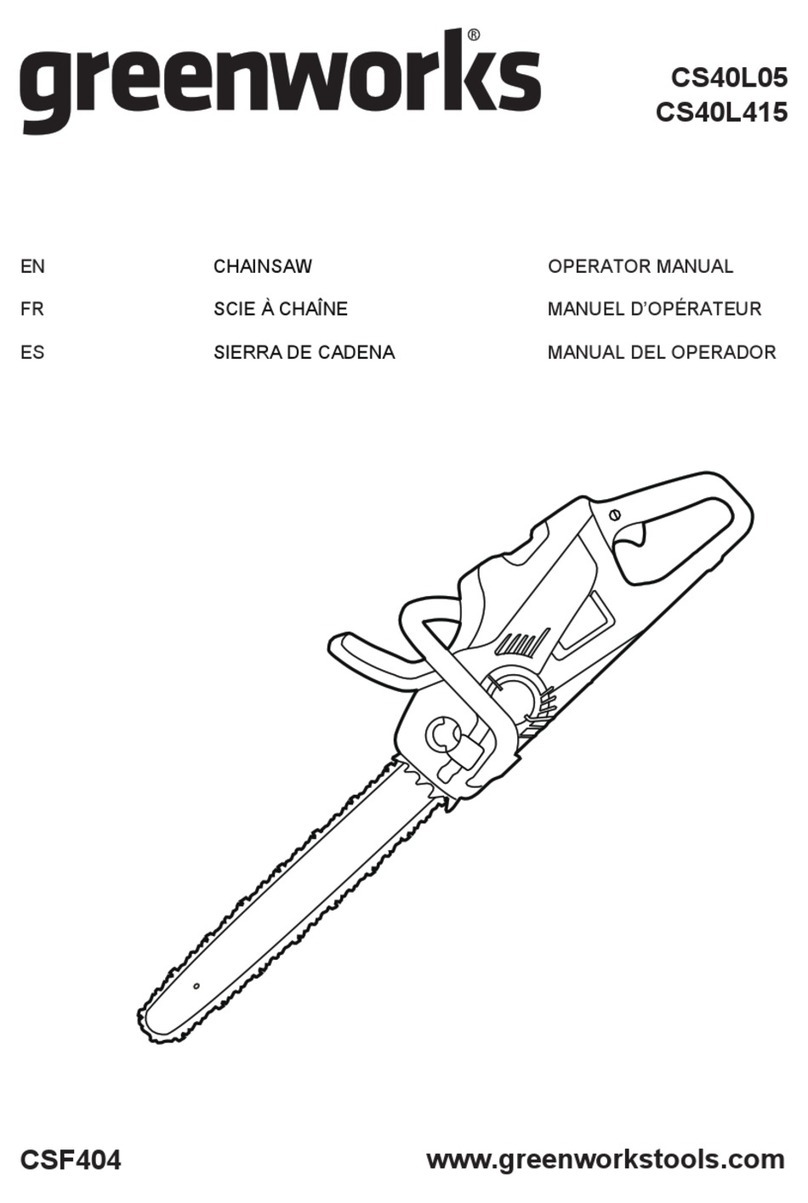
GreenWorks
GreenWorks CS40L05 Operator's manual
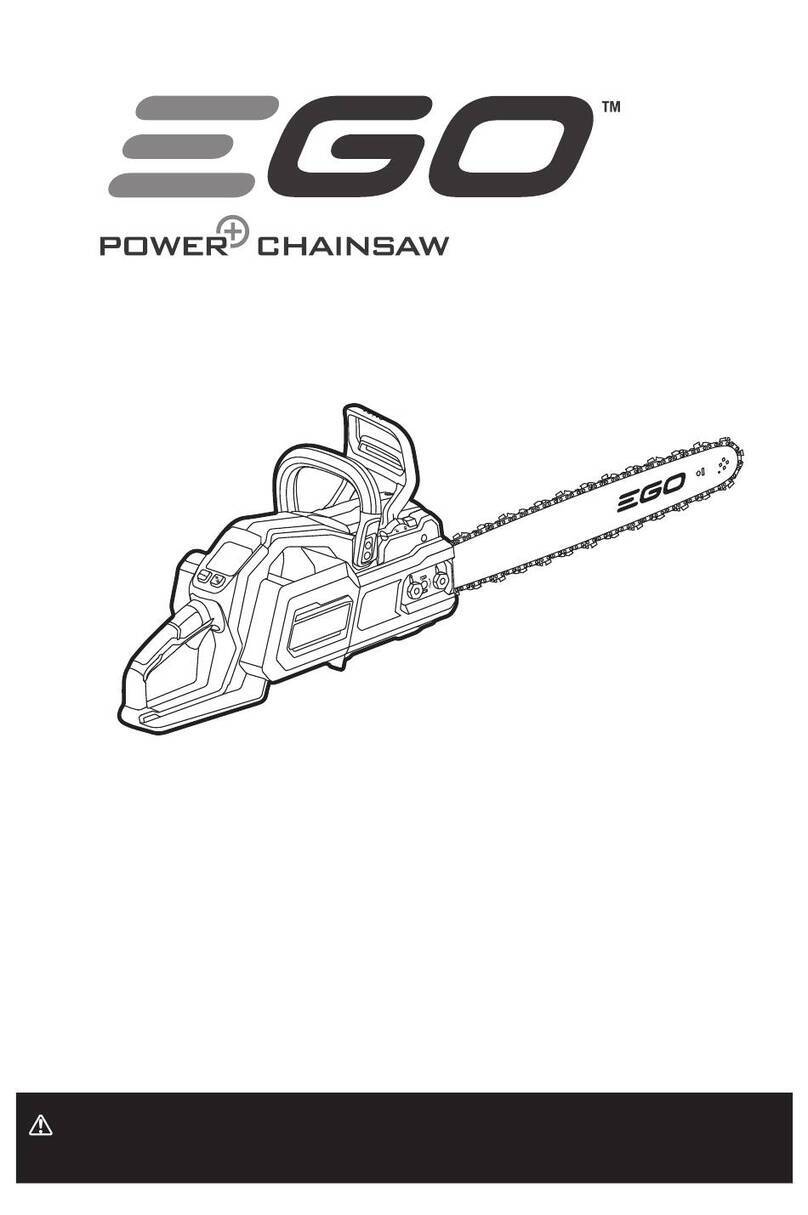
Ego Power+
Ego Power+ CS2000E Operator's manual

GreenWorks
GreenWorks GD40CS15 Operator's manual

TOOLCRAFT
TOOLCRAFT AKS-200 Original instructions

Salem Master Pro
Salem Master Pro 6220G Assembly & Use Manual
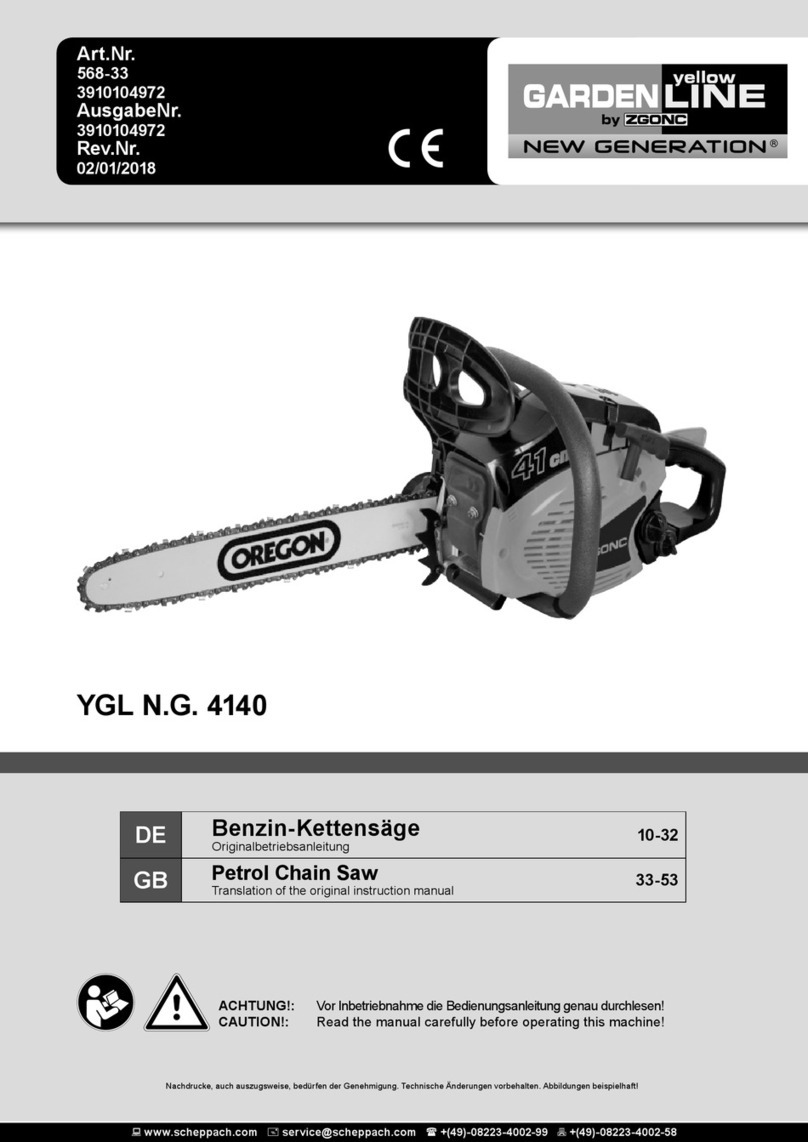
Zgonc
Zgonc Yellow Garden Line New Generation 56833 Translation of the original instruction manual

